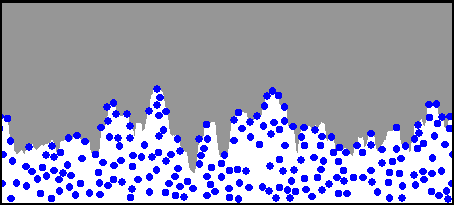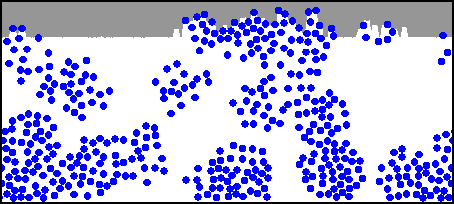The durability and attractiveness of paint or more generally organic coatings is crucial to the marketability and performance of manufactured products as disparate as automobiles,kitchen sinks and computer screens. Despite this, research on the scientific basis for appearance remains fragmented and in many cases dependent on the work performed decades ago by the National Bureau of Standards. The advent of environmental regulations and advances in material technology has stimulated the development of new coatings so a renewed effort in this area is a natural part of NIST's mission.
We undertook a study of the relation between the coating microstructure as
formulated during the manufacturing process and the appearance of a painted
surface after it has been damaged by UV radiation, as typically occurs during
weathering due to outdoor exposure. We devised a computer simulation of the
changes in microstructure that occur in a thin outer layer of a paint coating
consisting of pigment particles and polymeric binder. The model shows the
changes in morphology as the direction of Ultraviolet radiation and degree and
mode of damage is varied. Variables that determine the coating microstructure
during formulation such as pigment volume concentration, pigment size
distribution and degree of pigment particle clustering or flocculation are
parameters of the model. Random placement approximating a close packing
distribution and the Neymann-Scott clustering process are used to generate
coating microstructures and to parameterize the distribution of pigment
particles. As a first approximation we chose to focus on gloss, the aspect of
appearance that is at once of commercial importance and is a factor that is
largely dependent on surface morphology through a surface roughness variable.
This has been shown both experimentally and in theoretical work based on
physical theories of light scattering (see Beckmann and Spizzichino, "The
Scattering of Electromangnetic Waves From Rough Surfaces") . The dependence of
surface roughness on pigment particle size distribution and degree of
flocculation was investigated. Despite the obvious complexity of the weathering
process we found similarities in the dependence of high gloss on the presence
of many small well dispersed pigment particles as was seen in earlier studies
of unweathered surfaces. The dependence of surface roughness on PVC however
varied significantly with the degree of weathering. Below are figures from the
simulation. Figure ![]() shows coating with a high degree of
flocculation. This is very common in poorly mixed or "de- mixed" paints. All
pigment distributions are so-called hard core random fields so there is no
overlap.
shows coating with a high degree of
flocculation. This is very common in poorly mixed or "de- mixed" paints. All
pigment distributions are so-called hard core random fields so there is no
overlap.

Caption: Graphic of simulation shows weathered surface with air shown above in gray and a thin layer of paint below. Spheres depict titanium dioxide pigment particles that are randomly placed in polymeric binder shown in white PVC=25.

Caption: Same PVC as above but minimum nearest neighbor distance is larger, decreasing the flocculation. Note surface roughness has decreased and thus surface will have glossier appearance.

Caption: Spheres depict titanium dioxide pigment particles that are randomly placed according to the Matern cluster process a simple type of Neymann-Scott point process.
We proposed the construction of computer graphic images of surfaces depicting these relationships that could be used to visualize the trade-offs of various formulation strategies. These images could play a potentially important role in producing coatings with the most desirable gloss characteristics, given the constraints of cost and ease of manufacture. An interdisciplinary group consisting of Hunt, scientists from BFRL, Physics, and Manufacturing Engineering Laboratory was formed to develop and propose a research program at NIST in cooperation with industrial and academic colloborators. It would use advanced optical technology and metrology on the one hand and modelling and the use of computer graphic surface rendering on the other to identify and measure coating characteristics that produce surfaces with high quality appearance characteristics. The proposal recently won a NIST wide competition for competency funding for the next fiscal year and the group is in the process of planning the first stages of the project.